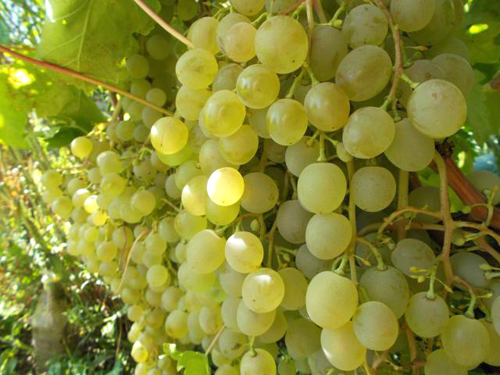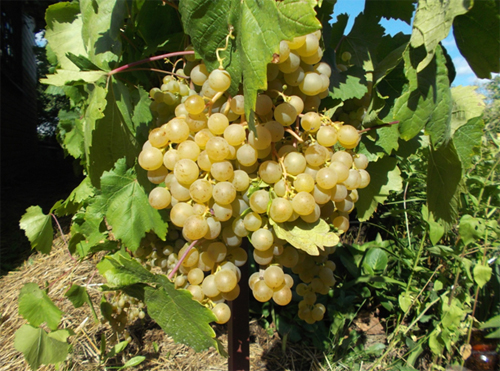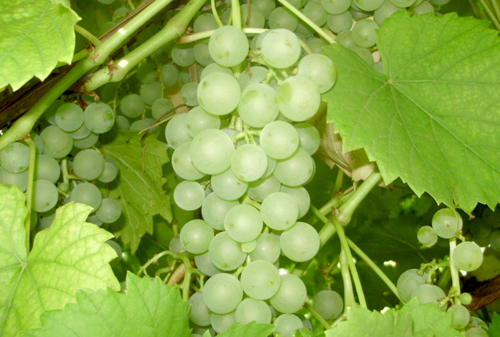Grape variety Krasa Severa (Olga)
The beauty of the north, or, as it is also called, Olga, is one of the interesting varieties of table grapes, bred more than half a century ago in the Central Genetic Laboratory named after V.I. IV Michurin, now transformed into the All-Russian Research Institute of Genetics and Selection of Fruit Plants, located in Michurinsk, Tambov Region. The authors of the hybrid form were a family couple of breeders - Lena Timofeevna Shtin and Ivan Maksimovich Filippenko. According to one version, the second name, Olga, was given to the hybrid in honor of the daughter of the researchers.

The task of the breeders was to develop new forms of grape plants that are able to feel comfortable and give decent in terms of volume and quality harvests in regions of the middle zone of the country that are not traditional for viticulture. To fulfill it, they experimented a lot with varieties and hybrids that have genes for frost-resistant Amur grapes in their DNA, which were crossed with high-quality southern varieties of the "sun berry". So the Beauty of the North was the result of pollination of the technical, half Amur variety Zarya North, the pollen of the magnificent ancient Central Asian Taifi pink.
The result of crossing, as is often the case, turned out to be, so to speak, a "compromise". In particular, the novelty showed increased frost resistance, although it did not quite reach the indicators of the maternal form, but at the same time the clusters turned out to be quite large and pleasant to the taste, due to the partially transmitted heredity from the paternal variety. However, the most important property, thanks to which Olga began to be considered a truly northern grape, was her early maturity and a very modest need for warmth.
For 17 long years, from 1977 to 1994, Krasa Severa underwent variety testing, as a result of which it was entered into the State Register of Breeding Achievements and allowed for industrial cultivation in the Central Black Earth Region of the country. In addition to Russia, our heroine has become widespread in Belarus, the Baltic republics, Kazakhstan, and domestic grape lovers cultivate it far beyond the zoned regions. Even despite the recent appearance of many magnificent hybrids that surpass Olga both in the attractiveness of the bunches and in terms of ripening, she continues to remain popular among many of her loyal admirers.
Agrobiological characteristics
The bushes are highly vigorous. The leaves of the variety are large, dark green, three-lobed with a weak degree of dissection. The leaf surface is rough, shagreen; the underside is covered with very weak cobweb pubescence. The lateral notches are usually almost invisible, or very shallow in the shape of a recessed corner. The petiolate notch is predominantly open, vaulted, or lyre-shaped, in most cases with a sharp bottom. Petioles are long with a noticeable anthocyanin tint in color. The denticles along the edge of the leaf blade of grapes are low, dome-shaped. The flowers are bisexual, pollination under normal weather conditions occurs without problems, but in some seasons one has to deal with pea berries. There is no predisposition to shedding flowers and ovaries. The vine ripens satisfactorily, but the length of the mature shoots is always sufficient for optimal spring pruning.

The bunches of the Beauty of the North grow medium-sized by modern standards. Their usual weight is about 250 grams, the shape is conical or branched, the structure is moderately dense, sometimes even loose. The maximum brush size reaches 400 grams. The comb is long and fragile, pale green, often pink at the base. The berries of the variety are above average in size, round or slightly oval, white in color with pink tones on the sunlit side.The weight of a hundred grapes is, as a rule, 280-330 grams. The berries are freely located in the brush, due to which they do not damage each other and do not deform, however, the unevenness of their sizes somewhat reduces the external attractiveness of the bunches. The pulp is very juicy, even spreading, the taste is simple but pleasant, in the aftertaste there are slight tones of astringency and herbiness, transmitted from the skin. The juice is colorless, its sugar content is 16-17 g / 100 ml, the titratable acidity is 5-6 g / l. There is a remarkably high content of folic acid, or vitamin B9, in berries, due to which they can be very useful for pregnant women. The skin of the berries is thin, translucent in the light, but at the same time strong, covered with a thin layer of protective pruin bloom, easy to chew. The seeds are small, 2-3 per berry; they do not have a noticeable negative effect on the palatability. Grape tasting score - 8 points.
The variety is grown mainly in household plots, and is used, as a rule, for their own consumption. The Krasa North has no great market prospects, since this niche is occupied by modern, albeit less cold-resistant, but at the same time highly commercial varieties. Grown in amateur plots, Olga's harvest has the versatility of directions of use. In addition to fresh consumption, it is suitable for making juice, compotes, and preserves at home. All these preparations will come in handy in the winter period, when people lack many vitamins contained in the "sun berry".
The popularity of this variety in the northern regions is due to the short growing season of the plants. It takes only 110 days from budding in spring until the ripe grapes are ready for harvest. During this period of time, he needs only 2150-2250 ° C of the sum of active temperatures. Such heat supply is typical for Chelyabinsk, Kazan and Moscow, which determines the ability to cultivate the Beauty of the North in the open ground up to these regions. However, the possibilities of the variety are not limited to this. Being one of the best options for growing in film greenhouses, it is quite capable of growing even further north in the simplest unheated protected ground structures. Its frost resistance, although it is increased to -25 ... -26 ° C, is nevertheless insufficient for non-covering cultivation in the most severe conditions.

His yield indicators are quite high. From a bush that has entered full fruiting, up to 12 kg of grapes can be harvested without any special problems, without fear of overloading the plant with the crop. Larger volumes are possible, but in this case there is a danger of lengthening the growing season, deteriorating the palatability of the berries and a general weakening of the bushes in the event that their vital energy is insufficient for such abundant productivity. By the way, it is quite difficult to overload the variety, since the percentage of fruitful shoots and the number of bunches on each of them are at an average level. The first indicator is at the level of 50−55%, the second - in the region of 1.1−1.3.
The beauty of the north is quite resistant to cracking of berries and gray rot, so that the crop can continue to hang on the vine even after ripening, if of course the climatic conditions allow in terms of the absence of frost. However, it is necessary to take into account the susceptibility of Olga's grapes, protected only by a thin skin, to the attack of wasps, hornets and other insects. In addition, feathered pests can also be actively interested in grapes, in relation to which it is also necessary to provide protection measures.
Agrotechnical features
Despite its adaptability to northern growing conditions, the variety has a high adaptive ability, adapting to different climates, in particular, growing well in arid regions of traditional viticulture. In the process of cultivation, it does not differ in particular exactingness, although it needs timely care, especially in terms of combating diseases.
When planting, the requirements are not much different from other varieties of grapes. The soil should be as light as possible, structured, water and breathable.High fertility is not a prerequisite, however, in order to ensure the rapid development of the Beauty of the North in the first years after planting, it is necessary to fill the planting pit well with fertilizers, to carry out regular watering and feeding with macro- and microelements. The site must be provided with heat, for which in areas that are risky in terms of SAT sufficiency, grapes are planted on the slopes of warm exposures, or on the southern side of various buildings or dense fences, where they will be protected from cold northern winds. A sufficient moisture supply is preferable, however, the variety tolerates moderate drought better than planting in damp and wetlands, as well as areas with a high level of groundwater.

The need to shelter the aboveground part of the bushes for the winter is determined in accordance with local climatic conditions and Olga's extreme frost resistance. In the case of a guaranteed absence of winter cold below -25 ° C, the culture can be cultivated on a high stem without any insulation. In this case, powerful plants will be able to accumulate a significant stock of perennial wood, which will have a beneficial effect on large-fruited and the quality of the crop. In more severe conditions, even the Krasa of the North will need shelter, for which the bushes should be formed not high from the ground in order to be able to remove the vine from the trellis without damage for subsequent insulation. Most often, in such cases, domestic winegrowers use schemes like a multi-arm fan or an oblique cordon. In some, figuratively speaking, "transitional" regions, it makes sense to try to apply a combined formation, in which the bulk of the grape bush is cultivated on a trunk, and a lightweight covering lower tier is withdrawn as a reserve, which allows you to quickly restore a full-fledged aboveground part, in case of severe damage by extreme cold weather.
Due to the low fruitfulness of Olga's shoots, the load on the variety during spring pruning is increased - 40−45 eyes, with an average length of fruit arrows - 8-10 eyes. Excess shoots, first of all sterile, and then the weakest ones are removed when broken before flowering. After that, the number of productive young vines should remain within 20-24 pieces. Brushes should not be thinned on them.
One of the biggest disadvantages of the Beauty of the North is its susceptibility to such harmful diseases of the grapes as mildew and powdery mildew. To combat them, multiple spraying with fungicides will be required, the number of which can reach 7-8 per season. Crop protection will also be required from wasps and birds, with the most reliable option being placing the bunches in special protective bags, where they will remain safe until the very collection.








